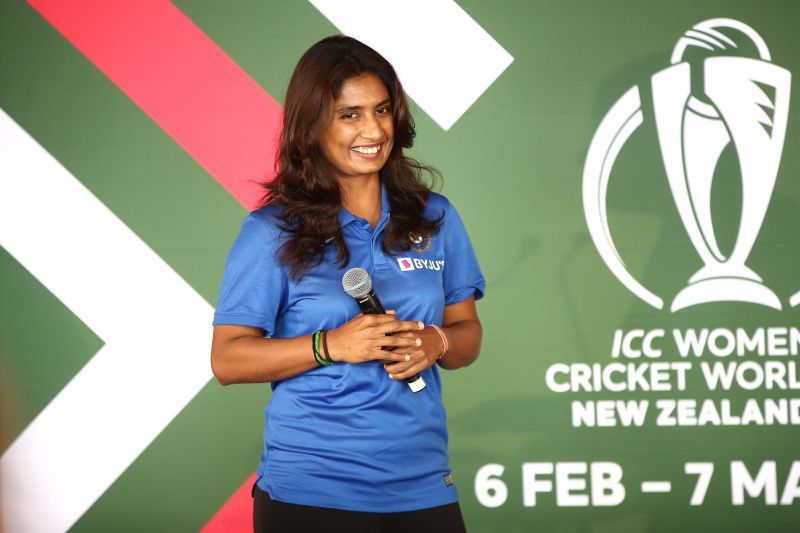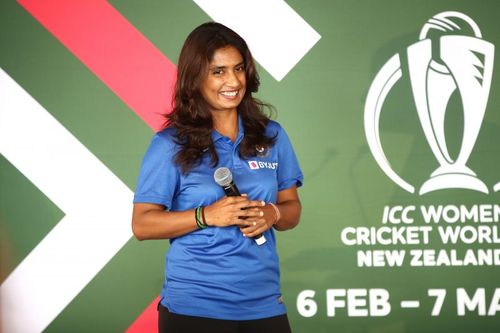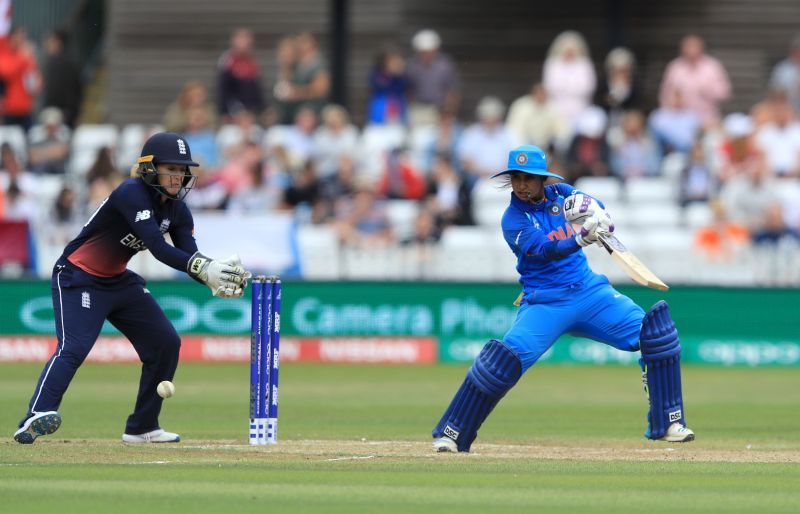
Mithali Raj: "For women’s cricket, I don’t see Tests as a format to promote the game"

What can one say about a cricketer who has performed at the highest level for two decades? Well, Mithali Raj’s performances speak for themselves. She is the highest run-getter in ODIs, and has a host of other records to her name.
With 3 Test wins (out of 6), 82 ODI wins (out of 132) and 17 T20I wins (out of 32) as captain, Raj is by far the most successful Indian skipper. Her win percentages of above 50% across all formats, another record she holds, is testimony to her leadership skills.
She graciously accepted our request for a chat on her career, the 2021 World Cup and women’s cricket in general.
In 1999, when you made your debut, women’s cricket wasn’t given much importance. How was the struggle in the initial days?
We were under a different board then (Women’s Cricket Association of India), and there were financial constraints. There were very few sponsorship deals. Often, the girls would be spending on the DA & TA from their own pockets. If the parents were keen, like my parents, they invested everything into my training and equipment, and even my first tour in 1999 was sponsored by my school and my dad’s bank.
Did you have any particular goal in mind when you started off?
Well, I think goals keep changing in every phase of your life. When you get into school, you want to be the topper, after passing out you want to get into a good college, and after that you want a good job. You can’t be stagnant with one goal.
For me, before making my debut, like it would be for any youngster, the first goal was to play for India. Once you play for India, the next goal is to cement your place in the side. So, at every stage I had different goals.
In your first Test innings (in 2002 against England at Lucknow) you scored a duck, but you haven’t looked back since. Can you talk about your state of mind then?
Honestly, if you ask me now, I don’t remember. As you said, it happened a long time ago. I can only assume that I would have had the apprehensions that any youngster would in that situation. When you don’t score much in your first game, you think that you will be dropped for the next game or series. So, that is what probably was going through my mind.

What has been your most memorable moment on the field?
I can’t pinpoint one particular instance because everything adds up to what it is today. If not for those moments, I wouldn’t have the confidence that I have today when I walk on to the ground. All those matches which we pulled from the brink of losing, and also those which we lost from a winning position, have helped me learn, irrespective of the result.
Speaking of memorable moments, I think the first time people actually noticed women’s cricket, especially in my state Andhra Pradesh (now Telangana), was when I broke the world record for the highest score in women's cricket in 2002 (with 214 in a Test match against England in Taunton).
Then came the 2005 World Cup, but again, it didn’t really garner that much publicity. We didn’t get the required boost despite being the runners-up.
I think it was in 2009 that people really started to notice women’s cricket, and it accelerated with the Test match win in 2014 (against South Africa). These were the building blocks for the spread of awareness about women’s cricket.
The real big break came in the 2017 World Cup when we reached the finals. Now, women’s cricket was being noticed even by a common man. Until then, only cricketers or other athletes were aware about it. 2017 got everybody hooked to women’s cricket.
Do you think women’s cricket needs more Test matches?
From a cricketer’s point of view, I would love to play Test matches. You can ask any cricketer (male or female) - they value the Test cap.
However, given that we have to promote women’s cricket, as we are still not where men’s cricket is, I think T20s and ODIs are the means used by many boards. If you see, even in men’s cricket, they are trying to revive Tests. So for women’s cricket, I don’t see Tests as a format to promote the game.
Undoubtedly, as a cricketer, I would love to play more Tests, but I made my debut when Tests were beginning to fade and ODIs were gaining prominence.
You are one of the few cricketers who has taken the decision to leave T20Is and focus on ODIs. What made you take that decision?
People think that T20 cricket is a short format, but it is an intense one which moves so fast. The number of matches in a year has increased, and since I aim to play the 2021 World Cup, I need to have adequate time for preparation in the One Day format. That is purely the reason why I chose to play ODIs and quit T20s. I want to keep myself fresh and be prepared for that one last shot.
Given that there will be limited games before the 2021 World Cup due to the coronavirus outbreak, how can the Indian team prepare for it?
Firstly, I think it is important to know whether we have to play the qualifiers or get direct entry into the World Cup, and we are still waiting for the ICC's decision. Once this corona crisis subsides, we will have to see how big a window we have for the preparations. Every team’s scheduling will be re-looked, not only ours. We will have to reschedule everything that has been planned till the World Cup.
I am sure that in this quarantine period, every athlete will be trying to keep themselves fit in whatever way they can. We are so used to going to the ground every day after we wake up, but in the current scenario, there isn’t much choice. After all, when it comes to life, there isn’t anything above that.
What does your day in the current lockdown look like?
I get my schedule from my trainer and I do my workouts in the morning. During the day, I try to keep myself busy with cleaning my wardrobe, reading, watching Netflix or sketching. If we can follow a routine, it will help in dealing with the situation. You can’t just while away your time, people would go mad like that (laughs). For the first two-three days, I found it difficult, until I came up with a routine.
Do you sketch often?
No, the last time I did that was two-three years ago. For me, sketching is just a stress buster. Only if I am mentally relaxed, I will sit down to sketch. Obviously, we don’t have anything for a month or so, and hence I have the time as I am not constantly running.
Our domestic structure, Under-19s, and A-tours still need some improvement. In this scenario, do you think we are ready for a full-fledged women’s IPL?
If we keep pondering on these lines, I don’t think we will ever conduct an IPL for women. At some point, you need to start. When the team has done so well in the recently concluded T20 World Cup, it is important to cash in on the momentum. Even if it means we have it for a lesser number of teams, we should do it. If required, the rule of a certain number of overseas players in the squad can be accordingly modified for women.
It is important to start it because that’s how the franchise will hunt talent, and that can be a platform other than the domestic cricket. The standard of domestic cricket will also be increased if the girls play in the IPL, as they will got more exposure. It will help in the overall growth of women’s cricket.
It will assist the selectors in unearthing more talent, as in the case of Shafali (Verma). I don't think I would have seen her if not for these challengers.
As a senior cricketer, what’s your advice to Shafali Verma?
I wouldn’t talk much in terms of skill because every player is very different and they grow with experience. She is talented, no doubt about it. Yes, she is very young. I think, in these times of widespread social media and this growth phase for women’s cricket, it is important that these girls (not only Shafali) are guided in the right way. It is easy for them at that age to get distracted.
So, it is important to have parents or mentors around, to see that the focus is channelised in the desired manner.
Do you think that the board can do something in this respect? Maybe have a mental conditioner?
We can’t really put everything on the board. You can’t expect a school to keep an eye on the children when they go home. At home, they are looked after by their parents. So, in the same way, the board can only help us when we are on a tour or in camps. At other times, it is the players' responsibility.
When it comes to the Under-19 or India-A teams, it makes sense to have someone with the team.
How would you rate the BCCI’s role in the promotion of women’s cricket?
It has been very good. In fact, even in times like these (lockdown situation), we got a mail from the BCCI President assuring us, and this helps, as we look to our leaders to guide us.
They have made efforts to ensure that we go well ahead in time for any tour to acclimatise. The result of this can be seen in our performance in the last few ICC tournaments. They have also started with the emerging team tours.
In my view, for the last two-three years, the BCCI has been doing well to promote women’s cricket. The biggest plus was when we got the central contract in place. It helped the players who were the sole earning members in their families.
It also allows the players to focus on the game, and we don’t lose out on them. In the past, we have lost many good players due to monetary issues.
What are your views on the recently concluded 2020 T20 World Cup?
When you know that the batting department is not coming through, it is a worry. Nobody other than Shafali was contributing too much, and there was a lot depending on her. So, the day she failed, we were bound to crumble.
As far as the Australians are concerned, they had a very strong side. They had more depth in their batting than us. For us, it was only the top four, but I still feel that sometimes you need luck to favour you to win. Additionally, we had an excellent bowling attack, probably one of the best in the tournament.
Going back to your career, who has been the best captain that you have played under so far?
I have not played much under my seniors, but as a deputy to Mamatha Maben, I did learn a lot. She led the country for two years in 2003-04.
When you play under different captains, you try to pick the best attributes from all of them. For example, somebody could be good at man-management, and somebody else at planning. Nobody is perfect, but everyone has some good qualities, and that’s what I looked for when playing under others.
Whom did you look to for guidance or ideas while leading the team?
The seniors did help me, and a lot of quality players like Neetu David, Nooshin Al Khadeer and Hemlata Kala, among others, were around.
Those days, we had to stay in dormitories, so the communication between the players was lot more than what it is today. We had to travel by train, and that gave us a lot of time together. It helped in planning, and also for me to understand the players.
Who is the most difficult bowler that you have faced?
Lucy Pearson, the left-arm fast bowler from England. Those days, we used to play on local county grounds, and the wickets were mostly unprepared. On such wickets, it was really challenging to play her.
Who is your all-time favourite player?
I have two all-time favourites – Neetu David (India) and Karen Rolton (Australia).
What’s your take on having a mixed-doubles format for cricket?
As of now, I don’t think it is possible. You have to see women’s cricket from a different lens than men's cricket, and it will still be very attractive. If you start to compare, then probably you will be disappointed. Take the case of average bowling speed, there is a difference of 20-30 kmph between men’s and women’s cricket.
So, practically, I don’t think it is possible. But at a grassroots level, such as in schools, you should promote boys playing with girls. When you walk around in the city, you see only boys playing cricket, and that’s where you have to encourage girls to play with them. That mindset has to change. Maybe we can have the training sessions and friendly matches at school level together.
Moving on, the flip-side of being a star is that you also get roped in in many controversies. How do you deal with it?
There are two ways in which this (controversies) happens. One is the repercussion of a decision that you have made, and the second in which you are pulled into it without doing anything.
In situations where it is because of your decision, you try to learn from it. But in the second case, when you have played no role and still find yourself a part of the controversy, the best thing to do is to be patient.
I think the biggest challenge in such situations is to endure it quietly and patiently (like in the recent one with the team management where I could have spoken, but I didn’t want to create more chaos).
People try to use your name in certain ways and I am aware of that. If sport has taught me anything, it is to handle defeat with grace and not to be vindictive.
The only thing I will try to do is to be as honest as possible.
Who influenced you in the early days?
Father, mother and my dance teacher. From a cricketing stand point, I received a lot of guidance from GS Laxmi who played for India, Railways and Andhra Pradesh. As a senior, she used to pass on her experience.
What is your message to aspiring female cricketers?
It’s a good time to take women’s cricket as a career option. Like in any profession, put in hard work to get your basics right. I did that, and it helped me to sustain for so many years.
I see a lot of parents coming in and asking the coaches in how many years their kid will play for India. They are in a hurry to see the success of their child. However, the progress happens slowly, and it doesn’t happen overnight, unless you win a lottery or in a casino.
In life, everything comes at a price. Nothing comes easy. Both parents and players need to understand this.